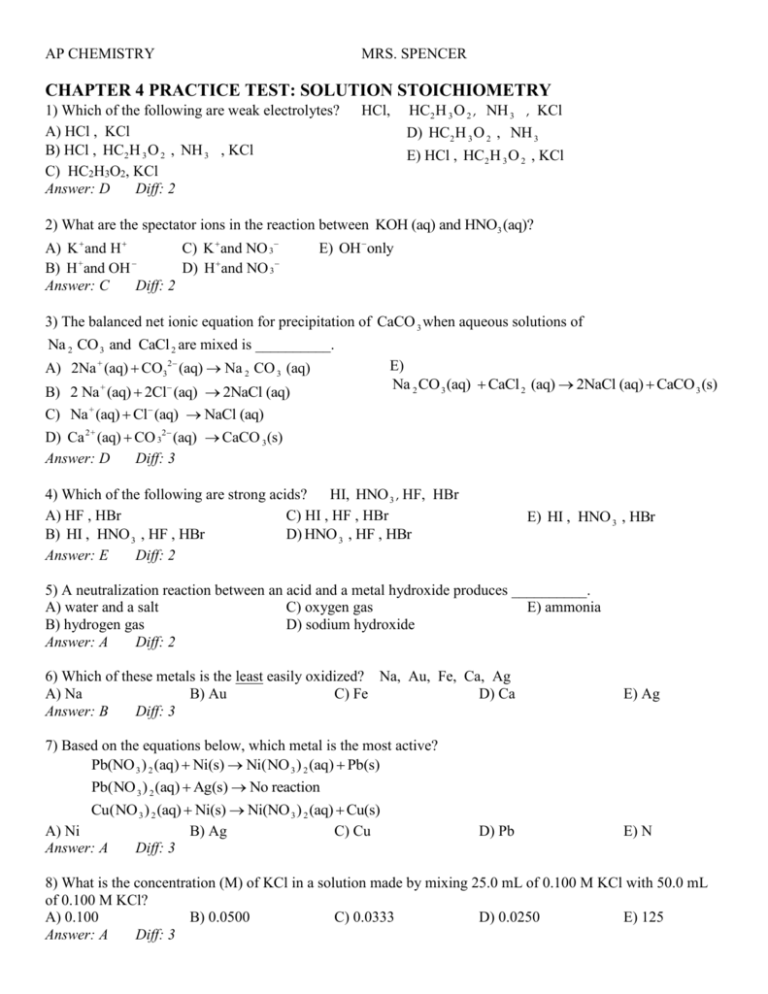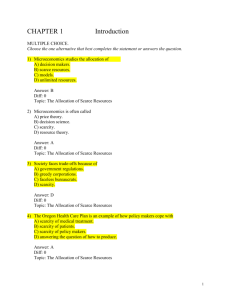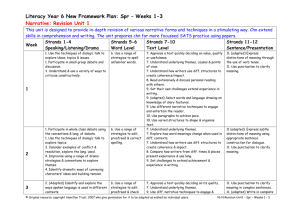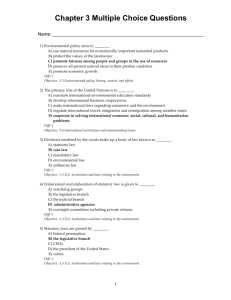AP Chemistry: Solution Stoichiometry Practice Test
advertisement

AP CHEMISTRY MRS. SPENCER CHAPTER 4 PRACTICE TEST: SOLUTION STOICHIOMETRY 1) Which of the following are weak electrolytes? A) HCl , KCl B) HCl , HC2 H 3 O 2 , NH 3 , KCl C) HC2H3O2, KCl Answer: D Diff: 2 HCl, HC2 H 3 O 2 , NH 3 , KCl D) HC2 H 3 O 2 , NH 3 E) HCl , HC2 H 3 O 2 , KCl 2) What are the spectator ions in the reaction between KOH (aq) and HNO3 (aq)? A) K and H C) K and NO 3 B) H +and OH D) H and NO 3 Answer: C Diff: 2 E) OH only 3) The balanced net ionic equation for precipitation of CaCO 3 when aqueous solutions of Na 2 CO 3 and CaCl 2 are mixed is __________. E) A) 2Na + (aq) CO32 (aq) Na 2 CO 3 (aq) Na 2 CO 3 (aq) CaCl 2 (aq) 2NaCl (aq) CaCO 3 (s) B) 2 Na + (aq) 2Cl (aq) 2NaCl (aq) C) Na + (aq) Cl (aq) NaCl (aq) D) Ca 2+ (aq) CO 32 (aq) CaCO 3 (s) Answer: D Diff: 3 4) Which of the following are strong acids? HI, HNO 3 , HF, HBr A) HF , HBr C) HI , HF , HBr B) HI , HNO 3 , HF , HBr D) HNO 3 , HF , HBr Answer: E Diff: 2 E) HI , HNO 3 , HBr 5) A neutralization reaction between an acid and a metal hydroxide produces __________. A) water and a salt C) oxygen gas E) ammonia B) hydrogen gas D) sodium hydroxide Answer: A Diff: 2 6) Which of these metals is the least easily oxidized? Na, Au, Fe, Ca, Ag A) Na B) Au C) Fe D) Ca Answer: B Diff: 3 7) Based on the equations below, which metal is the most active? Pb(NO 3 ) 2 (aq) Ni(s) Ni(NO 3 ) 2 (aq) Pb(s) Pb(NO 3 ) 2 (aq) Ag(s) No reaction Cu(NO 3 ) 2 (aq) Ni(s) Ni(NO 3 ) 2 (aq) Cu(s) A) Ni B) Ag C) Cu Answer: A Diff: 3 D) Pb E) Ag E) N 8) What is the concentration (M) of KCl in a solution made by mixing 25.0 mL of 0.100 M KCl with 50.0 mL of 0.100 M KCl? A) 0.100 B) 0.0500 C) 0.0333 D) 0.0250 E) 125 Answer: A Diff: 3 9) How many grams of H 3 PO 4 are in 175 mL of a 3.5 M solution of H 3 PO 4 ? A) 0.61 B) 60 C) 20 D) 4.9 Answer: B Diff: 3 E) 612 10) How many moles of K + are present in 343 mL of a 1.27 M solution of K 3 PO 4 ? A) 0.436 B) 1.31 C) 0.145 D) 3.70 Answer: B Diff: 3 E) 11.1 11) A 25.5 mL aliquot of HCl (aq) of unknown concentration was titrated with 0.113 M NaOH (aq). It took 51.2 mL of the base to reach the endpoint of the titration. The concentration (M) of the acid was __________. A) 1.02 B) 0.114 C) 0.454 D) 0.113 E) 0.227 Answer: E Diff 4 12) When aqueous solutions of __________ are mixed, a precipitate forms. A) NiBr 2 and AgNO 3 C) K 2 SO 4 and CrCl 3 B) NaI and KBr D) KOH and Ba(NO 3 ) 2 Answer: A Diff: 2 13) In which reaction does the oxidation number of oxygen increase? A) Ba(NO 3 ) 2 (aq) K 2 SO 4 (aq) BaSO 4 (s) 2KNO 3(aq) B) HCl (aq) NaOH (aq) NaCl (aq) H 2O (l) C) MgO (s) H 2 O (l) Mg(OH) 2 (s) D) 2 SO 2 (g) O 2 (g) 2 SO 3 (g) E) 2 H 2 O (l) 2 H 2 (g) O 2 (g) Answer: E Diff: 3 14) In which species does sulfur have the highest oxidation number? A) S 8 (elemental form of sulfur) C) SO 2 B) H 2 S Answer: E E) Li 2 CO 3 and CsI E) K 2 SO 4 D) H 2 SO 3 Diff: 3 15) Of the reactions below, only __________ is not spontaneous. A) Mg (s) 2HCl (aq) MgCl 2 (aq) H 2 (g) D) 2Al (s) 6HBr (aq) 2AlBr 3 (aq) 3H 2 (g) B) 2Ag (s) 2HNO 3(aq) 2AgNO 3(aq) H 2 (g) E) Zn (s) 2HI (aq) ZnI 2 (aq) H 2 (g) C) 2Ni (s) H 2 SO 4 (aq) Ni 2 SO 4 (aq) H 2 (g) Answer: B Diff: 4 16) Oxidation is the __________ and reduction is the __________. A) gain of oxygen, loss of electrons D) gain of oxygen, loss of mass B) loss of oxygen, gain of electrons E) gain of electrons, loss of electrons C) loss of electrons, gain of electrons Answer: C Diff: 2 17) Which one of the following is a correct expression for molarity? A) mol solute/L solvent C) mmol solute/mL solution B) mol solute/mL solvent D) mol solute/kg solvent Answer: C Diff: 3 E) μmol solute/L solution 18) Pure acetic acid (HC 2 H 3 O 2 ) is a liquid and is known as glacial acetic acid. Calculate the molarity of a solution prepared by dissolving 10.00 mL of glacial acetic acid at 25 °C in sufficient water to give 500.0 mL of solution. The density of glacial acetic acid at 25 °C is 1.05 g/mL. B) 21.0 C) 0.0210 D) 0.350 A) 1.26 × 103 E) 3.50 × 10-4 Answer: D Diff: 4 19) Lead ions can be precipitated from aqueous solutions by the addition of aqueous iodide: Pb 2 (aq) 2I (aq) PbI 2 (s) Lead iodide is virtually insoluble in water so that the reaction appears to go to completion. How many milliliters of 3.550 M HI(aq) must be added to a solution containing 0.700 mol of Pb(NO 3 ) 2 to completely precipitate the lead? B) 394 C) 197 D) 0.197 E) 0.394 A) 2.54 × 10-3 Answer: B Diff: 4 20) How many milliliters of 0.132 M HClO 4 solution are needed to neutralize 50.00 mL of 0.0789 M NaOH? A) 0.521 B) 0.0120 C) 83.7 D) 0.0335 E) 29.9 Answer: E Diff: 3 2010 Advanced Placement Chemistry Examination Form B Section II – Free Response Questions Beginning with the 2007 examination, the numerical problems, 1, 2, and 3, are Part A. Students may use a calculator for this part (55 minutes). Part B (40 minutes) is the three reactions question (predict the products of a reaction, balance, and answer a short question regarding the reaction) and the two theory questions. A laboratory question could be in either part A or B. NO calculator is allowed in part B. * * * Part A * * * Time – 55 minutes YOU MAY USE YOUR CALCULATOR FOR PART A. CLEARLY SHOW THE METHOD USED AND STEPS INVOLVED IN ARRIVING AT YOUR ANSWERS. It is to your advantage to do this, because you may earn partial credit if you do and you will receive little or no credit if you do not. Attention should be paid to significant figures. Be sure to write all your answers to the questions on the lined pages following each question in this booklet. Answer Question 1, 2, and 3. The Section II score weighting for each question is 20 percent. Answer Question 4 below. The Section II score weighting for this question is 10 percent. (Note: I have included below only 1 of the 3 reactions listed in this question.) 4. For (each of) the following (three) reaction(s), in part (i) write a balanced equation for the reaction and in part (ii) answer the question about the reaction. In part (i), coefficients should be in terms of lowest whole numbers. Assume that solutions are aqueous unless otherwise indicated. Represent substances in solutions as ions if the substances are extensively ionized. Omit formulas for any ions or molecules that are unchanged by the reaction. You may use the empty space at the bottom of the next page for scratch work, but only equations that are written in the answer boxes provided will be graded. (a) Solid copper(II) sulfate pentahydrate is gently heated. (i) Balanced equation: (ii) How many grams of water are present in 1.00 mol of copper(II) sulfate pentahydrate? Answer Question 5 and Question 6. The Section II score weighting for these questions is 15 percent each. Your responses to these questions will be graded on the basis of the accuracy and relevance of the information cited. Explanations should be clear and well organized. Examples and equations may be included in your responses where appropriate. Specific answers are preferable to broad, diffuse responses. 2010 B 5. (a) (b) (c) (d) A solution of 0.100 M HCl and a solution of 0.100 M NaOH are prepared. A 40.0 mL sample of one of the solutions is added to a beaker and then titrated with the other solution. A pH electrode is used to obtain the data that are plotted in the titration curve shown above. Identify the solution that was initially added to the beaker. Explain your reasoning. On the titration curve above, circle the point that corresponds to the equivalence point. At the equivalence point, how many moles of titrant have been added? The same titration is to be performed again, this time using an indicator. Use the information in the table below to select the best indicator for the titration. Explain your choice. Indicator pH Range of Color Change Methyl violet 0 - 1.6 Methyl red 4-6 Alizarin yellow 10 - 12 (e) What is the difference between the equivalence point of a titration and the end point of a titration? (f) On the grid provided on the next page, sketch the titration curve that would result if the solutions in the beaker and buret were reversed (i.e., if 40.0 mL of the solution used in the buret in the previous titration were titrated with the solution that was in the beaker).











